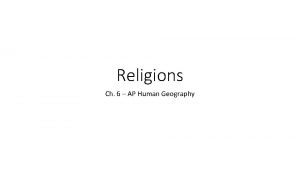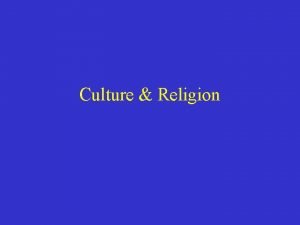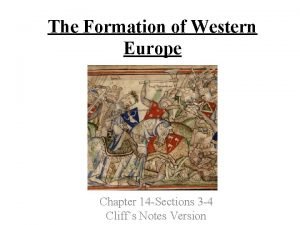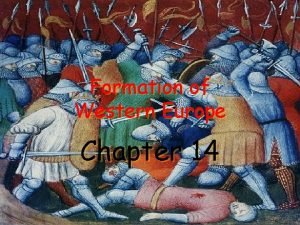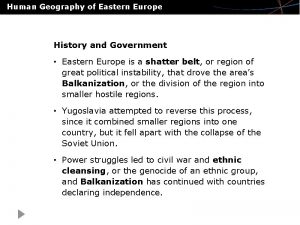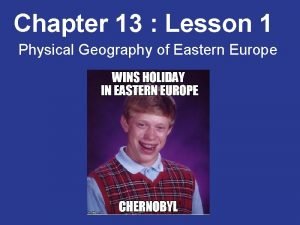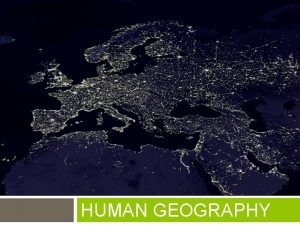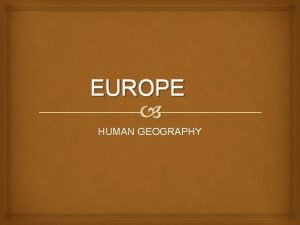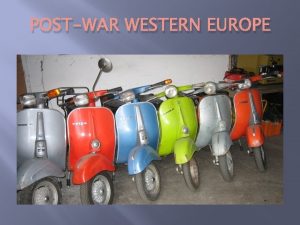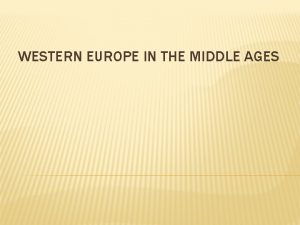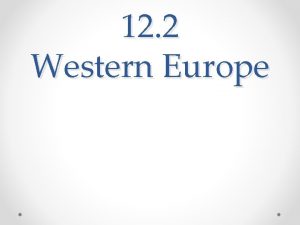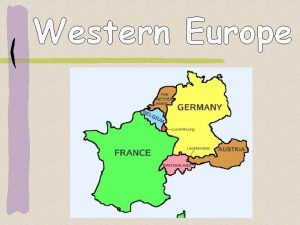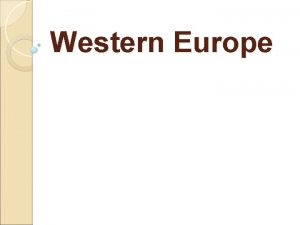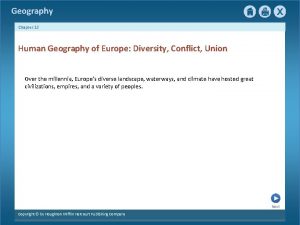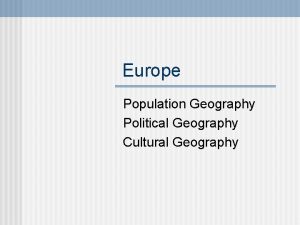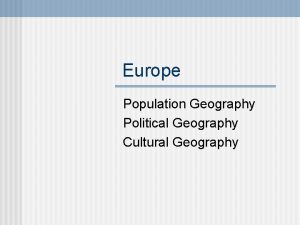Chapter 13 Human Geography of Europe WESTERN EUROPE












- Slides: 12

Chapter 13: Human Geography of Europe WESTERN EUROPE

I. A. A History of Cultural Divisions French and German Culture 1. France, Germany are region’s largest, most productive countries 2. French, German culture also strong in Benelux countries § Benelux countries—Belgium, the Netherlands, Luxembourg Rome to Charlemagne 1. Rome conquered Celtic tribes in modern-day France, so French is a Romance language 2. didn’t conquer Germanic tribes, so Germanic languages still exist § Germanic king Charlemagne conquers area in late 700 s after his death, his empire falls into small, competing kingdoms C. The Reformation 1. In 1517, Martin Luther’s critical 95 statements launch Reformation 2. many Christians break from Catholic Church, formed Protestant churches B.

II. The Rise of the Nation-States A. Nationalism 1. Feudalism—Middle Ages system where lords own most of the land § Lords give some land to nobles; strong kings gain power over lords 2. Nationalism develops—belief people should be loyal to their nation § Nationalism leads to growth of nation-states 3. European nation-states like France, Austria, and German states (united as a nation in 1871) had conflicts (1600 s-1945) 4. Colonies became an issue – countries fought over territory around the world

B. Modern Conflicts 1. Nationalistic rivalry, competition for colonies cause WWI § Allied Powers (France); Central Powers (Germany, Austria. Hungary) § Allied Powers win WWI; harsh terms forced on Germany lead to WWII 2. In WWII, Nazi Germany’s Adolf Hitler tries to conquer Europe § Nazis carry out Holocaust—mass murder of European Jews, others § Allies defeat Germany in 1945 § Germany split – Berlin Wall separates communist East Germany (USSR) and non-communist West until 1989; democratic reforms in the 1990 s and European Union established

III. Economics: Diversity and Luxury A. Agriculture to High-Tech 1. Belgium, France, the Netherlands, and Switzerland – agriculture (dairy, wheat, grapes, etc. ) 2. France, Germany, the Netherlands – coal and iron ore = industry 3. The Netherlands, Germany – high-tech electronics, services § 4. France – nuclear energy and space programs Switzerland (neutral) – banking and finance B. Tourism and Luxury 1. Tourism is major industry – good climate and history 2. Luxury goods like clothing and watches

IV. A. B. 1. 2. Great Music and Art Music 1. Germany: Johann Sebastian Bach, Ludwig van Beethoven 2. Austria: Wolfgang Amadeus Mozart Painting Dutch painters § Jan Van Eyck (from Flanders), Jan Vermeer, Rembrandt, Major French painters § Claude Monet, Paul Cezanne, Paul Gauguin, Pierre Auguste Renoir

Jan Vermeer

Rembrandt

Paul Gauguin

Pierre Auguste Renoir

Claude Monet

V. Modern Life A. City Life 1. High standard of living because of strong economies 2. Most Western Europeans live in cities 3. good public transportation, cultural attractions, low crime rates 4. Most homes are small, so socializing is done in public cafés, parks B. Recent Conflicts 1. Immigration – Yugoslavians and Turks coming to Germany for work = conflict/discrimination amongst Germans 2. Austrian leader Joerg Haider defended ex-Nazis increasing racism (anti-Semitism)
 Chapter 13 human geography of europe
Chapter 13 human geography of europe Primal indigenous religion ap human geography
Primal indigenous religion ap human geography Taliban vs western values ap human geography
Taliban vs western values ap human geography Chapter 14 the formation of western europe
Chapter 14 the formation of western europe Chapter 14 the formation of western europe
Chapter 14 the formation of western europe Human geography of eastern europe
Human geography of eastern europe Ap human geography frq examples
Ap human geography frq examples 5 themes of geography ap human geography
5 themes of geography ap human geography Proruption ap human geography
Proruption ap human geography Human development index definition ap human geography
Human development index definition ap human geography Vocabulary activity 12 cultural geography of europe
Vocabulary activity 12 cultural geography of europe Chapter 13 lesson 1 physical geography of eastern europe
Chapter 13 lesson 1 physical geography of eastern europe Mount elbrus
Mount elbrus

